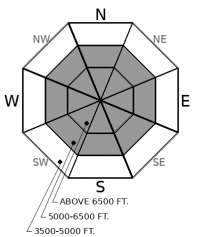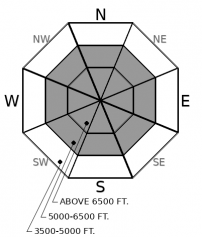| Monday | Monday Night | Tuesday | |
|---|---|---|---|
| Cloud Cover: | Mostly cloudy | Mostly Cloudy | Partly Cloudy |
| Temperatures: | 20 to 25 deg. F. | 8 to 13 deg. F. | 18 to 23 deg. F. |
| Wind Direction: | Southwest | Southwest | Southwest |
| Wind Speed: | 10 to 20 mph, gusting to 30 | 10 to 15 mph, gusting to 25 | 5 to 10 mph, gusting to 20 |
| Snowfall: | 5 to 10 in. | 0 to 2 in. | 0 in. |
| Snow Line: | 1000 ft | 500 ft | 500 ft |
Whitefish Range
How to read the forecast
Snow and wind will continue to increase the hazard through the day, forming slabs in the upper snowpack. These will increase in size and distribution as you gain elevation. Monitor new snow totals and reactivity of fresh slabs. A remotely triggered 4 foot slab yesterday confirms that buried weak snow is capable of producing a large avalanche. Select planar or concave terrain with a consistent snow depth to avoid this problem and be wary of overhead hazards.

2. Moderate
?
Above 6500 ft.
2. Moderate
?
5000-6500 ft.
1. Low
?
3500-5000 ft.
- 1. Low
- 2. Moderate
- 3. Considerable
- 4. High
- 5. Extreme
-
Type ?
-
Aspect/Elevation ?

-
Likelihood ?CertainVery LikelyLikelyPossible
 Unlikely
Unlikely -
Size ?HistoricVery LargeLargeSmall

Snow overnight and into the early afternoon will form thin slabs at mid and upper elevations. Slabs will become more widespread and reactive as the day progresses. Moderate to strong southwest winds will form thicker slabs below ridgelines and on cross-loaded slopes. Surface cracking in fresh slabs is a sign of instability. Monitor new snow totals and surface bonding as you gain elevation. Be mindful of overhead hazards while traveling and opt for lower angle or less consequential terrain if you identify this problem.
-
Type ?
-
Aspect/Elevation ?

-
Likelihood ?CertainVery LikelyLikelyPossible
 Unlikely
Unlikely -
Size ?HistoricVery LargeLargeSmall

Yesterday's remotely triggered persistent slab in GNP on buried weak snow is bull's eye data that we still have a Persistent slab problem. These layers are isolated and difficult to trigger but remain a concern. Areas harboring a thin or variable snowpack are most susceptible. Terrain selection is THE WAY to manage this problem. Steer clear of steep convex rocky terrain where triggering a slide is most likely.
A storm system entered our area last evening and is ramping up this morning favoring the Flathead and the Swan Range with up to a foot of new snow. Observers yesterday in the Flathead range noted storm totals up to 8" and shallow instabilities breaking in the new snow. Fresh thin storm slabs should be expected this morning which will increase in size and distribution as the day progresses. Evaluate new snow totals and bonding between the new and old snow.
We received a report of a remotely triggered avalanche in John F Stevens Canyon yesterday. The avalanche was 200' wide, up to 4' deep and failed on buried weak layers. This is a good reminder at how Persistent slab avalanches can surprise us. They are a low probability high consequence problem as was unfortunately illustrated with the recent avalanche fatality outside of Choteau(outside of our forecast area). This avalanche was 2000' wide and 1-5' deep. Natural or human-triggered slides in the upper snowpack have the potential to step down and trigger these larger slabs. This is a difficult problem to manage with terrain selection being the best solution. Avoid steep convex rocky areas with planar or concave slopes containing a more uniform snowpack a better bet. Collapses in the snowpack, as observed yesterday near Ousel Peak, are clear signs to stay off of steeper terrain.
EDUCATION: We are offering the following upcoming classes: An Avalanche Awareness talk on Thursday, January 10 at The Stonefly Lounge at 7:00 p.m., a Motorized Level 1- Avalanche Fundamentals course on January 11-13, and a Ladies Introduction to Avalanches January 17 and 19
.
A weather system ramps up this morning with widespread snow, cooler temperatures, and windy conditions. Snow tapers off tomorrow with partial clearing.
This forecast applies only to backcountry areas outside established ski area boundaries. The forecast describes general avalanche conditions and local variations always occur. This forecast expires at midnight on the posted day unless otherwise noted. The information in this forecast is provided by the USDA Forest Service who is solely responsible for its content.



























